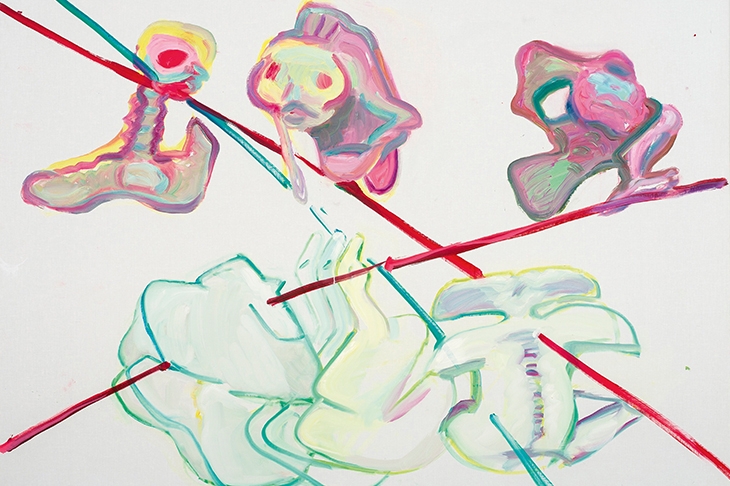How do you make a work of art? One method is to cut things up and stick them back together in a different order. That is, roughly speaking, the recipe for collage. Thus in 1934 Max Ernst snipped away at a pile of illustrations to 19th-century novels, reassembled them in an altered fashion, and came up with Une semaine de bonté — or A Week of Kindness — a surrealist novel in pictures.
Some of its pages are displayed in The Ends of Collage, at Luxembourg & Dayan, 2 Savile Row, W1. In one a woman reclines on an ornate, neo-baroque bed, while all around the waves of the sea are rippling over her coverlet; in another a male leaps astonishingly high in a moonlit street,
his head transformed into that of an enormous bird.
For my money, Ernst never did anything better (his paintings are generally much less powerful). In the right hands — wielding scissors and glue — collage can produce marvellous results. This exhibition looks at two points in its history: the early 20th century, the era of surrealism and dada, and the post-modernism of the 1970s and later. It raises the question of whether collage is the natural idiom for a cut-and-paste culture such as the one we live in today, surrounded by digitally altered and edited imagery.
That’s an intriguing question. But the actual works on show tend to suggest that collage has had its moment. The most compelling are mostly the older examples by Ernst, Miró, Arp and their contemporaries. The later ones tend to look weaker. Perhaps the conclusion is that collage works best when it is used in an idiom — such as surrealism — that positively benefits from the jerky discontinuity that comes from gluing images together.
To make a more coherent space you need to use another medium, such as painting or sculpture. There is plenty of both in Colour is at Waddington Custot, 11 Cork St. This is a mixed gallery show without much of a thesis, but it contains enough stunning items to make it well worth pausing for a look. It focuses on another way
of making art: covering something in a startling hue.
This was a popular strategy with sculptors in Sixties London. David Annesley’s ‘Orinoco’ (1965) is a beguiling example: two big squiggles of steel plate, welded together and painted a euphoric buttercup yellow. It feels like an abstract painting that has escaped into the room with you. The same effect is produced by a red relief by the Brazilian artist Hélio Oiticica, except that this floats in front of you, suspended from the ceiling.
Colour-field paintings, as they were known, work in an opposite way. Instead of creating an illusion into which you can wander in your imagination, as a representational picture might, they add a slab of chromatic vividness to your environment like a flat sculpture. A big John Hoyland from 1973 does just that. Colour-field art, having been out of style for a long while, is being reassessed at the moment (Damien Hirst has professed himself a fan of Hoyland, for example). It certainly has the advantage of instant visual deliciousness.
Monochrome, a small but exquisite exhibition round the corner at Ordovas, 25 Savile Row, investigates the reverse strategy. It consists of five three-dimensional works that are entirely white, or white-ish. Of course historically, in the western tradition, this has been quite normal. Bernini and Michelangelo routinely created people who were marble-pale (or alternatively bronze-toned).
This little display shows the effect of taking colour away: it makes you concentrate on form. In the case of stone carvings by Barbara Hepworth and the Spanish sculptor Eduardo Chillida, we are invited to pay attention to the interaction of geometric planes, some closer, some further away: rather a Zen kind of pleasure, compared with being smacked in the eye by a bucketful of colour.
Over the road, at Hauser & Wirth, there’s a large and impressive show devoted to the Austrian painter Maria Lassnig. She was in her sixties before her work was acclaimed, and only quite recently has her fame spread to Britain.
Like many of her contemporaries — the American Philip Guston comes to mind — Lassnig (1919–2014) tried various strategies during a long, long career: she lived to be 94, and although the last works in this show date from a few years before her death, they range from 1950 up to 2007.
At the beginning, Lassnig tried geometric abstraction of the loose gestural kind, then turned to figurative painting in the Sixties and Seventies moving on to weird, organic, doodily images that aren’t of anything easily nameable but are informed by experience of living in a body (she called this idiom ‘body awareness painting’).
Through it all runs a feeling that is personal and also indefinably Austrian. It’s partly to do with her preoccupation with self-examination, which recalls Schiele and Kokoschka. There are quite a few naked self-portraits, and also less literal pieces such as ‘Selbstporträt als Tier’ (‘Self-portrait as Animal’), 1963.
It’s also to do with colour. It’s a strange fact that a choice of palette can be as individual, almost, as a fingerprint and also culturally specific. There’s a range of bright pastel purples, pinks and lime-greens that come up in picture after picture by Lassnig. Somehow they are distinctively hers — and also very central European.






Comments